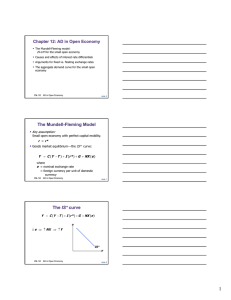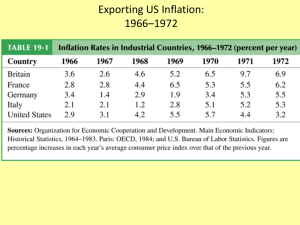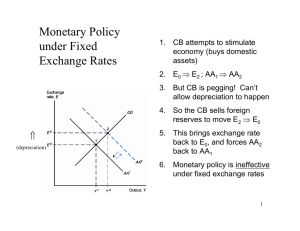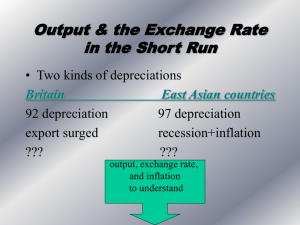solution
advertisement
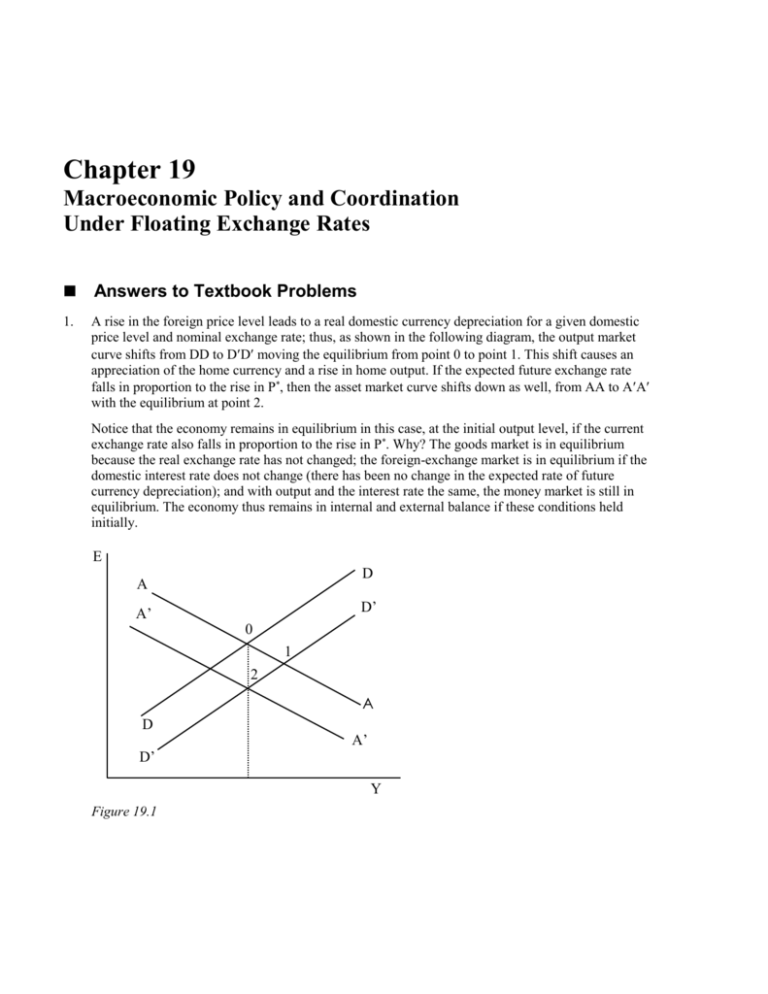
Chapter 19 Macroeconomic Policy and Coordination Under Floating Exchange Rates Answers to Textbook Problems 1. A rise in the foreign price level leads to a real domestic currency depreciation for a given domestic price level and nominal exchange rate; thus, as shown in the following diagram, the output market curve shifts from DD to DD moving the equilibrium from point 0 to point 1. This shift causes an appreciation of the home currency and a rise in home output. If the expected future exchange rate falls in proportion to the rise in P*, then the asset market curve shifts down as well, from AA to AA with the equilibrium at point 2. Notice that the economy remains in equilibrium in this case, at the initial output level, if the current exchange rate also falls in proportion to the rise in P*. Why? The goods market is in equilibrium because the real exchange rate has not changed; the foreign-exchange market is in equilibrium if the domestic interest rate does not change (there has been no change in the expected rate of future currency depreciation); and with output and the interest rate the same, the money market is still in equilibrium. The economy thus remains in internal and external balance if these conditions held initially. E D A D’ A’ 0 1 2 A D A’ D’ Y Figure 19.1 Chapter 19 2. Macroeconomic Policy and Coordination Under Floating Exchange Rates 115 A transitory increase in the foreign interest rate shifts the asset market curve up and to the right from AA to AA, as shown in the figure 19.2 (there is no change in the expected exchange rate since this is a temporary rise). Under a floating exchange rate there is thus a depreciation of the home currency and an increase in output. (The effect could differ in the IS-LM model, where the real interest rate influences aggregate demand directly; the DD curve would shift up and to the right as well.) Under a fixed exchange rate, however, the monetary authority must intervene to prevent the depreciation, so it contracts the home money supply by selling foreign exchange and drives the home interest rate to the new higher world level. This causes AA to return to its original position, leaving output unaffected. (Once again, the result would differ in the IS-LM model since foreign interest-rate shocks are not pure money-market disturbances in that model.) 116 3. Krugman/Obstfeld • International Economics: Theory and Policy, Seventh Edition The effect of a permanent rise in the foreign nominal interest rate depends upon whether that rise is due to an increase in inflationary expectations abroad or a rise in the foreign real interest rate. If the foreign real interest rate rises because of monetary contraction abroad, there is a long-run depreciation of the domestic currency which reinforces the depreciation that occurs in problem 2. The expansionary effect on home output is thus greater than in the transitory case. If the foreign nominal interest rate rises only because foreign inflationary expectations rise, however, the expectations effect goes the other way and the long-run expected price of foreign currency falls, shifting AA to the left. Domestic output need not rise in this case. Under a fixed exchange rate there is still no short run effect on the economy in the DD-AA model, but as P* starts to rise the home country will have to import foreign inflation. Under a floating rate the home economy can be completely insulated from the subsequent foreign inflation. E D A’ A A’ D A Y Figure 19.2 4. A rise in foreign inflation could arise from a permanent increase in foreign monetary growth. This causes the home currency to appreciate against the foreign currency, implying also a real appreciation (since P and P* are fixed in the short run). Domestic output therefore falls as foreign output rises. In the long run, relative PPP implies that the rate of domestic currency appreciation rises to offset the higher foreign inflation. The foreign nominal interest rate rises by the increase in expected inflation (the Fisher effect); the domestic nominal interest rate is the same as its initial long-run value; and by relative PPP, interest parity continues to hold. Notice that in this case, the expected future exchange rate moves over time to reflect the trend inflation differential. 5. We can include the aspect of imperfect asset substitutability in the DD-AA model by recognizing that the AA schedule now must equate M/P L(R* expected depreciation risk premium, Y). An increase in the risk premium shifts out the AA curve, leading to a currency depreciation and an increase in output. Output will not change under a fixed-exchange-rate regime: since the exchange rate parity must be preserved, there will be no depreciation and no effect on output. Chapter 19 6. Macroeconomic Policy and Coordination Under Floating Exchange Rates 117 In Chapter 18 there is an analysis of internal and external balance for fixed exchange rates. It is possible to construct a corresponding diagram for floating exchange rates. In figure 19.4, the vertical axis measures expansion of the money supply and the horizontal axis measures fiscal ease. The internal balance curve II has a negative slope since monetary restraint must be met by greater fiscal expansion to preserve internal balance. The external balance curve XX has a positive slope since monetary expansion, which depreciates the exchange rate and improves the current account, must be matched by fiscal expansion to preserve external balance. The “four zones of economic discomfort” are : Zone 1—overemployment and excessive current account surplus; Zone 2—overemployment and current account deficit; Zone 3—underemployment and current account deficit; Zone 4—underemployment and current account surplus. X I 1 Money Supply Growth 4 2 3 0 I X Fiscal Ease Figure 19.4 7. The diagram described in the answer to question 6 can be used to answer this question. The United States begins at point 0 after 1985, where it is in internal balance but there is a large current account deficit. In the short run, monetary expansion (an upward shift in the point) moves the economy toward the goal of a greater current account surplus, but also moves the economy out of internal balance toward overemployment. The expenditure-reducing policy of reducing the budget deficit (represented by a leftward shift in the point), used in tandem with an expenditure-switching monetary expansion, can restore external balance while maintaining internal balance. Moving the economy into a zone of overemployment puts pressure on the price level which ultimately reverses the short-run effect of monetary expansion on the real exchange rate. 8. Fiscal expansion in Germany and Japan would have appreciated the currencies of those countries and diminished the bilateral U.S. trade deficits with them, as desired by American officials. On the other hand, monetary expansion in these countries would have worsened the U.S. current account since the dollar would have appreciated relative to the deutschemark and the yen. Our two-country models suggests that U.S. output would have fallen as a result. These effects would differ, of course, if the United States altered its policies in response to policy changes in Germany or Japan. For example, if the United States expanded its money supply with the expansion in either Germany or Japan there would be no bilateral effects. If the United States contracted fiscal policy as Germany or Japan expanded fiscal policy there would less of an effect on output in each country. 118 9. Krugman/Obstfeld • International Economics: Theory and Policy, Seventh Edition Sterilized intervention has no effect on the supply of high-powered money. A way to check whether the Japanese interventions in 2003–4 was sterilized is to see if there are unusual movements in Japanese stocks of high-powered money around that time. The International Financial Statistics, published by the IMF, includes measures of reserve money (line 14) and reserves minus gold (line 1d). Below, we see the percentage change in both series from late spring 2003 to late spring 2004 (the peak of the intervention): Jun Jul Au Sep Oct No Dec Jan Feb Mare- - g- - - v- - - 04 03 03 03 03 03 03 03 04 04 rese 0.5 2.0 – 9.1 3.6 2.9 4.5 10. 4.9 6.4% rve % % 0.4 % % % % 3% % s % mo 0.9 – – 4.6 – 1.5 4.7 – – 3.0% ney % 0.1 0.2 % 3.8 % % 1.3 0.9 % % % % % There are some months where we see large increases in reserves and also large increases in high powered money (September and December 2003) which would suggest unsterilized intervention, but in general, the changes in reserves are not always accompanied by changes in high powered money. In particular, high powered money fell during the peak of intervention in January—February 2004, suggesting sterilization (or possibly offsetting factors in the economy for which we are not controlling). 10. One can construct a matrix analogous to figure 19A.1 in the text to show the change in inflation and the change in exports for each country in response to monetary policy choices by that country and by the other country. Export growth in a country will be greater, but inflation will be higher, if that country undertakes a more expansionary monetary policy, given the other country’s policy choice. There is, however, a beggar-thy-neighbor effect because one country’s greater export growth implies lower export growth for the other. Without policy coordination, the two countries will adopt overexpansionary monetary policies to improve their competitive positions, but these policies will offset each other and result simply in higher inflation everywhere. With coordination, the countries will realize that they can both enjoy lower inflation if they agree not to engage in competitive currency depreciation.




